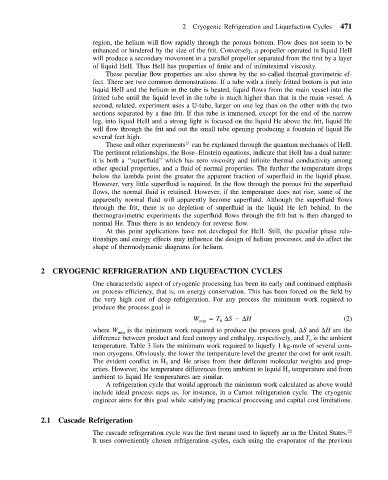Page 482 - Mechanical Engineers' Handbook (Volume 4)
P. 482
2 Cryogenic Refrigeration and Liquefaction Cycles 471
region, the helium will flow rapidly through the porous bottom. Flow does not seem to be
enhanced or hindered by the size of the frit. Conversely, a propeller operated in liquid HeII
will produce a secondary movement in a parallel propeller separated from the first by a layer
of liquid HeII. Thus HeII has properties of finite and of infinitesimal viscosity.
These peculiar flow properties are also shown by the so-called thermal-gravimetric ef-
fect. There are two common demonstrations. If a tube with a finely fritted bottom is put into
liquid HeII and the helium in the tube is heated, liquid flows from the main vessel into the
fritted tube until the liquid level in the tube is much higher than that in the main vessel. A
second, related, experiment uses a U-tube, larger on one leg than on the other with the two
sections separated by a fine frit. If this tube is immersed, except for the end of the narrow
leg, into liquid HeII and a strong light is focused on the liquid He above the frit, liquid He
will flow through the frit and out the small tube opening producing a fountain of liquid He
several feet high.
21
These and other experiments can be explained through the quantum mechanics of HeII.
The pertinent relationships, the Bose–Einstein equations, indicate that HeII has a dual nature:
it is both a ‘‘superfluid’’ which has zero viscosity and infinite thermal conductivity among
other special properties, and a fluid of normal properties. The further the temperature drops
below the lambda point the greater the apparent fraction of superfluid in the liquid phase.
However, very little superfluid is required. In the flow through the porous frit the superfluid
flows, the normal fluid is retained. However, if the temperature does not rise, some of the
apparently normal fluid will apparently become superfluid. Although the superfluid flows
through the frit, there is no depletion of superfluid in the liquid He left behind. In the
thermogravimetric experiments the superfluid flows through the frit but is then changed to
normal He. Thus there is no tendency for reverse flow.
At this point applications have not developed for HeII. Still, the peculiar phase rela-
tionships and energy effects may influence the design of helium processes, and do affect the
shape of thermodynamic diagrams for helium.
2 CRYOGENIC REFRIGERATION AND LIQUEFACTION CYCLES
One characteristic aspect of cryogenic processing has been its early and continued emphasis
on process efficiency, that is, on energy conservation. This has been forced on the field by
the very high cost of deep refrigeration. For any process the minimum work required to
produce the process goal is
W min T S H (2)
0
where W min is the minimum work required to produce the process goal, S and H are the
difference between product and feed entropy and enthalpy, respectively, and T is the ambient
0
temperature. Table 3 lists the minimum work required to liquefy 1 kg-mole of several com-
mon cryogens. Obviously, the lower the temperature level the greater the cost for unit result.
and He arises from their different molecular weights and prop-
The evident conflict in H 2
erties. However, the temperature differences from ambient to liquid H temperature and from
2
ambient to liquid He temperatures are similar.
A refrigeration cycle that would approach the minimum work calculated as above would
include ideal process steps as, for instance, in a Carnot refrigeration cycle. The cryogenic
engineer aims for this goal while satisfying practical processing and capital cost limitations.
2.1 Cascade Refrigeration
The cascade refrigeration cycle was the first means used to liquefy air in the United States. 22
It uses conveniently chosen refrigeration cycles, each using the evaporator of the previous

